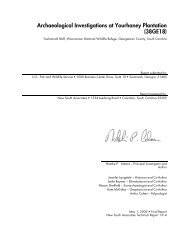Mills in the Upcountry: a Historic Context, and a Summary of a Mill ...
Mills in the Upcountry: a Historic Context, and a Summary of a Mill ...
Mills in the Upcountry: a Historic Context, and a Summary of a Mill ...
Create successful ePaper yourself
Turn your PDF publications into a flip-book with our unique Google optimized e-Paper software.
diameter <strong>and</strong> made <strong>of</strong> wood. Two doors were on <strong>the</strong> front <strong>of</strong> <strong>the</strong> mill <strong>and</strong> you entered on<br />
<strong>the</strong> left side. This mill washed away <strong>in</strong> 1946.<br />
Hendricks Store was built around 1918 after ano<strong>the</strong>r store burned. It closed <strong>in</strong> 1939,<br />
before World War II began. Cornmeal from <strong>the</strong> mill, clo<strong>the</strong>s, grocery items, fresh<br />
produce, homemade canned items, <strong>and</strong> even c<strong>of</strong>f<strong>in</strong>s were sold at Hendricks Store. It might<br />
be compared to an early "Wal-Mart."<br />
19 or 20. HUNTER' S MILL<br />
Near <strong>the</strong> Golden Creek Baptist Church <strong>in</strong> Norris sits a beautiful mill site called Hunter's<br />
<strong>Mill</strong>. William Hunter owned this mill. He came to <strong>the</strong> area <strong>in</strong> <strong>the</strong> 1820' s <strong>and</strong> later was a<br />
signer <strong>of</strong> <strong>the</strong> Ord<strong>in</strong>ance <strong>of</strong> Secession represent<strong>in</strong>g <strong>the</strong> Pickens District. The mill sat on <strong>the</strong><br />
banks <strong>of</strong> <strong>the</strong> Twelve Mile River. As with many o<strong>the</strong>r mills <strong>in</strong> Pickens County, he had a<br />
tannery located on <strong>the</strong> site. His tannery produced lea<strong>the</strong>r goods for <strong>the</strong> Confederate Army<br />
dur<strong>in</strong>g <strong>the</strong> War Between <strong>the</strong> States.<br />
William Hunter was a leader <strong>of</strong> <strong>the</strong> community. He was descended from Joseph <strong>and</strong> Mary<br />
McEldownie Hunter <strong>of</strong> Irel<strong>and</strong>. There are still descendants <strong>of</strong> William Hunter liv<strong>in</strong>g <strong>in</strong><br />
Pickens County. William Hunter acquired much l<strong>and</strong> <strong>and</strong> gave some for <strong>the</strong> Golden Creek<br />
Baptist Church.<br />
24. JAMESON MILL<br />
Jameson <strong>Mill</strong>, located <strong>of</strong>f Jameson Road <strong>in</strong> Easley, was built on <strong>the</strong> north fork <strong>of</strong> George' s<br />
Creek. The orig<strong>in</strong>al owner was William Jameson, Sr. Very little is known about <strong>the</strong><br />
history <strong>of</strong> <strong>the</strong> mill today. In <strong>the</strong> mid-1990’s, it was taken apart <strong>in</strong> numbered pieces <strong>and</strong><br />
moved to a storage facility <strong>in</strong> Georgia. Jameson <strong>Mill</strong> was unusual because <strong>the</strong> support for<br />
<strong>the</strong> flume was made <strong>of</strong> stone. Corn <strong>and</strong> wheat were ground at <strong>the</strong> mill. There was a cotton<br />
g<strong>in</strong> on <strong>the</strong> site.<br />
28. KAY MILL (PUCKETT MILL)<br />
The Kay <strong>Mill</strong>, located on <strong>the</strong> Old Seneca Road <strong>in</strong> Six Mile, has a lot <strong>of</strong> history beh<strong>in</strong>d its<br />
closed doors. In <strong>the</strong> mid-1900’s, it was a mach<strong>in</strong>e shop, not a grist mill. Kay <strong>Mill</strong> was<br />
created when <strong>the</strong> old Puckett <strong>Mill</strong> was moved to this site. Many years earlier, it had been<br />
moved here <strong>and</strong> <strong>the</strong> present owner' s gr<strong>and</strong>fa<strong>the</strong>r ran <strong>the</strong> mill <strong>and</strong> named it after his family<br />
name, Kay. Part <strong>of</strong> old Puckett <strong>Mill</strong> is believed to be <strong>the</strong> wooden build<strong>in</strong>g that is attached<br />
to <strong>the</strong> concrete mill build<strong>in</strong>g. It is <strong>in</strong> disrepair <strong>and</strong> part has fallen <strong>in</strong>.<br />
Kay <strong>Mill</strong>, built <strong>in</strong> <strong>the</strong> early 1900' s, is a medium-sized mill by size st<strong>and</strong>ards. The metal<br />
wheel part, rusted, yet proud, still st<strong>and</strong>s today. The Kay family built <strong>the</strong>ir house across<br />
<strong>the</strong> road from <strong>the</strong> mill <strong>and</strong> received electrical power from <strong>the</strong> mill <strong>and</strong> <strong>the</strong> water tank,<br />
which stored water for days. This was rare to f<strong>in</strong>d a water tank on <strong>the</strong> mill site (it still<br />
st<strong>and</strong>s). The house burned many years later <strong>and</strong> only <strong>the</strong> tall chimney rema<strong>in</strong>s. Kay <strong>Mill</strong><br />
later opened as a mach<strong>in</strong>e shop when <strong>the</strong> need for gr<strong>in</strong>d<strong>in</strong>g corn <strong>in</strong> <strong>the</strong> community ended.<br />
The river, flow<strong>in</strong>g along side <strong>the</strong> mill, is still a fast mov<strong>in</strong>g body <strong>of</strong> water. Kay <strong>Mill</strong> was<br />
recalled by some as be<strong>in</strong>g an “important part <strong>of</strong> <strong>the</strong> lives <strong>of</strong> farmers liv<strong>in</strong>g <strong>in</strong> <strong>the</strong> Six Mile<br />
community, <strong>and</strong> still holds a special place <strong>in</strong> <strong>the</strong> hearts <strong>of</strong> her older citizens.”







